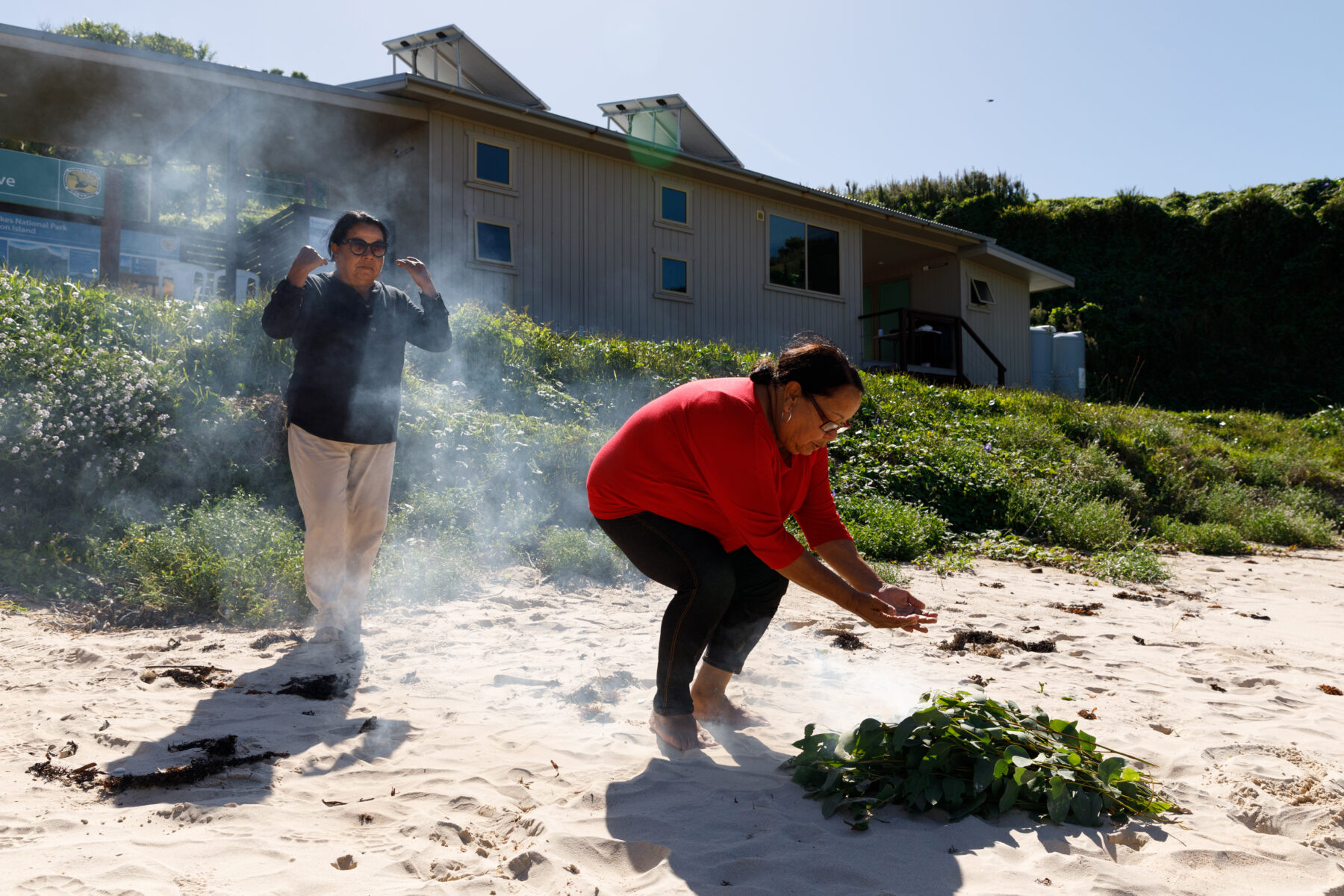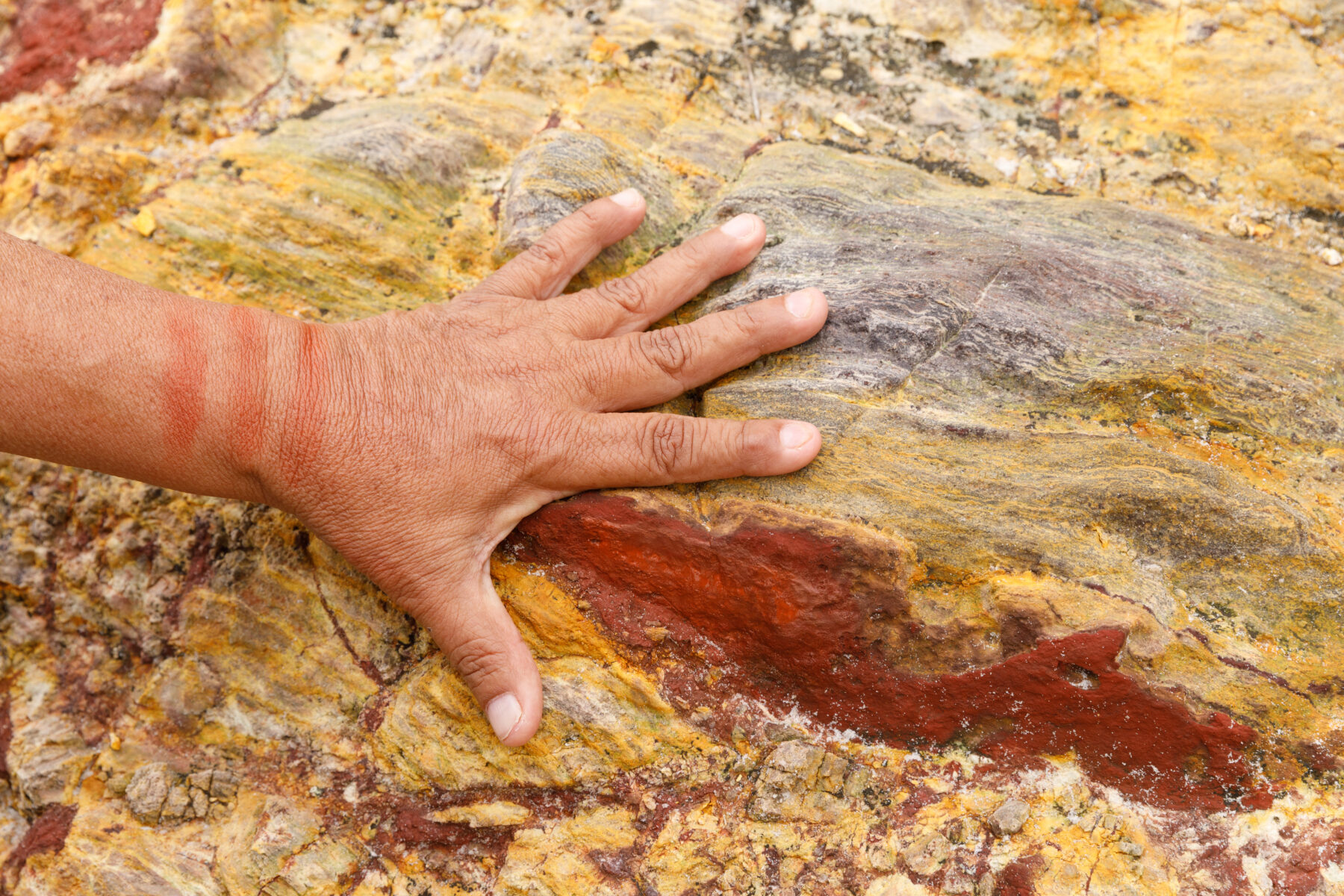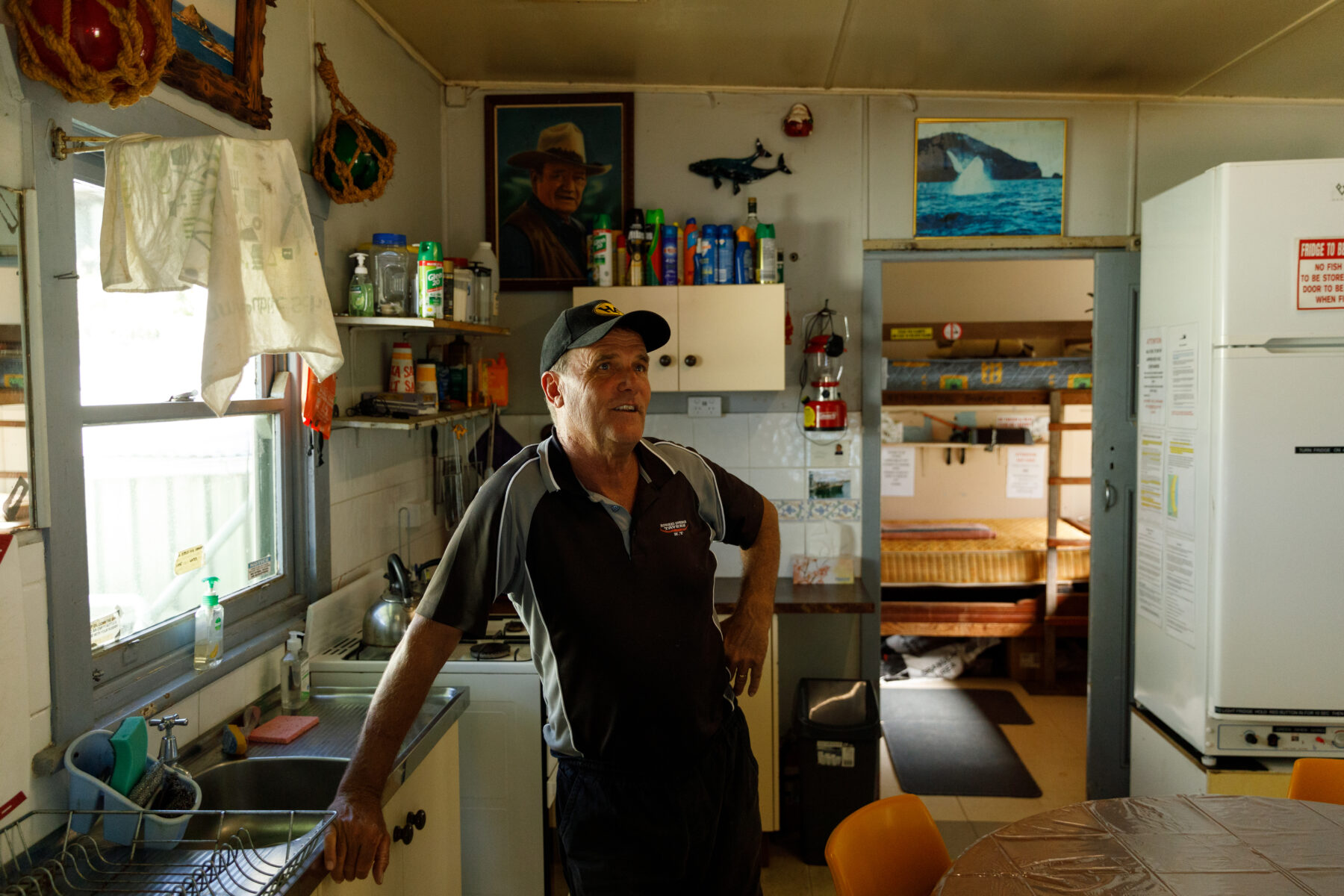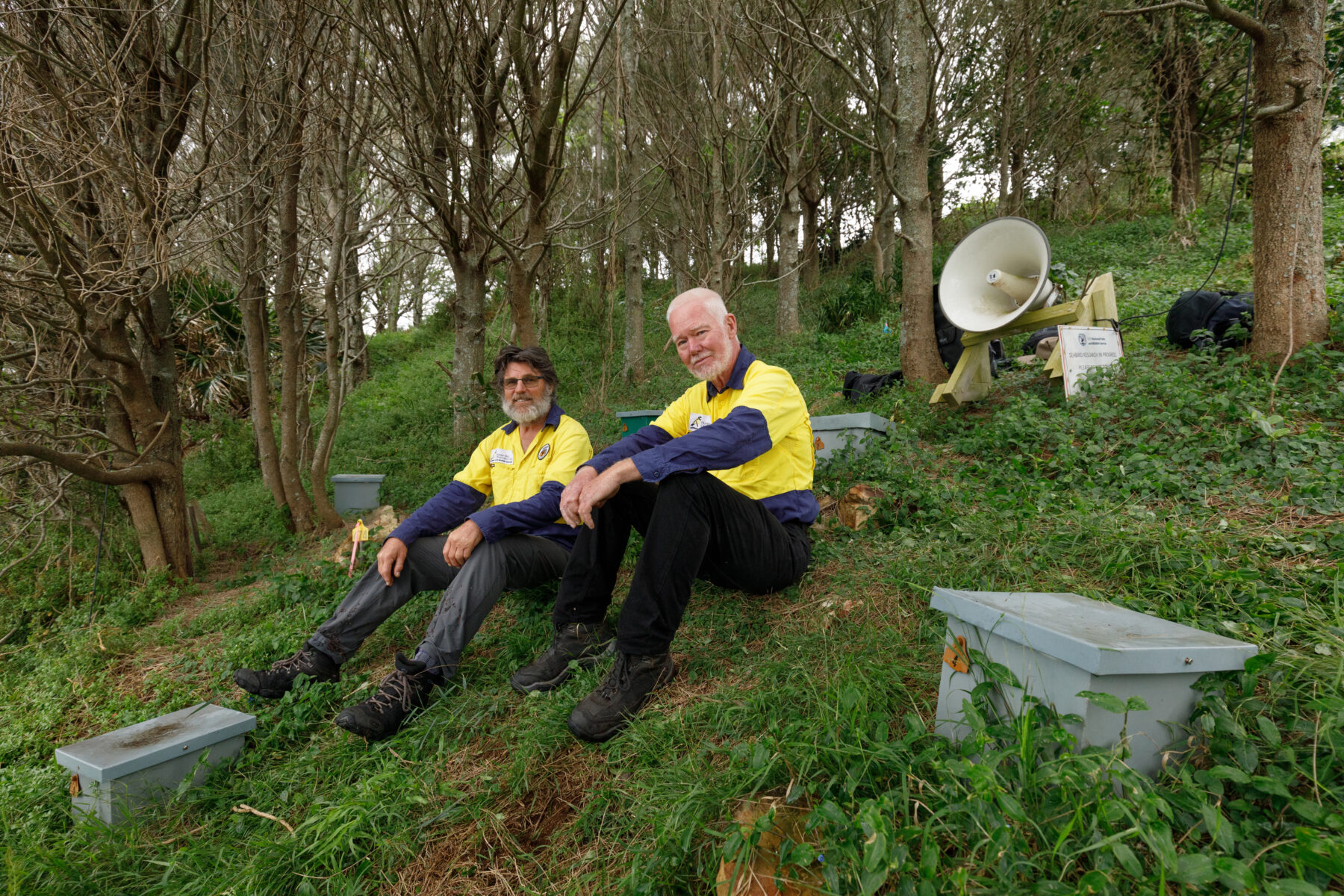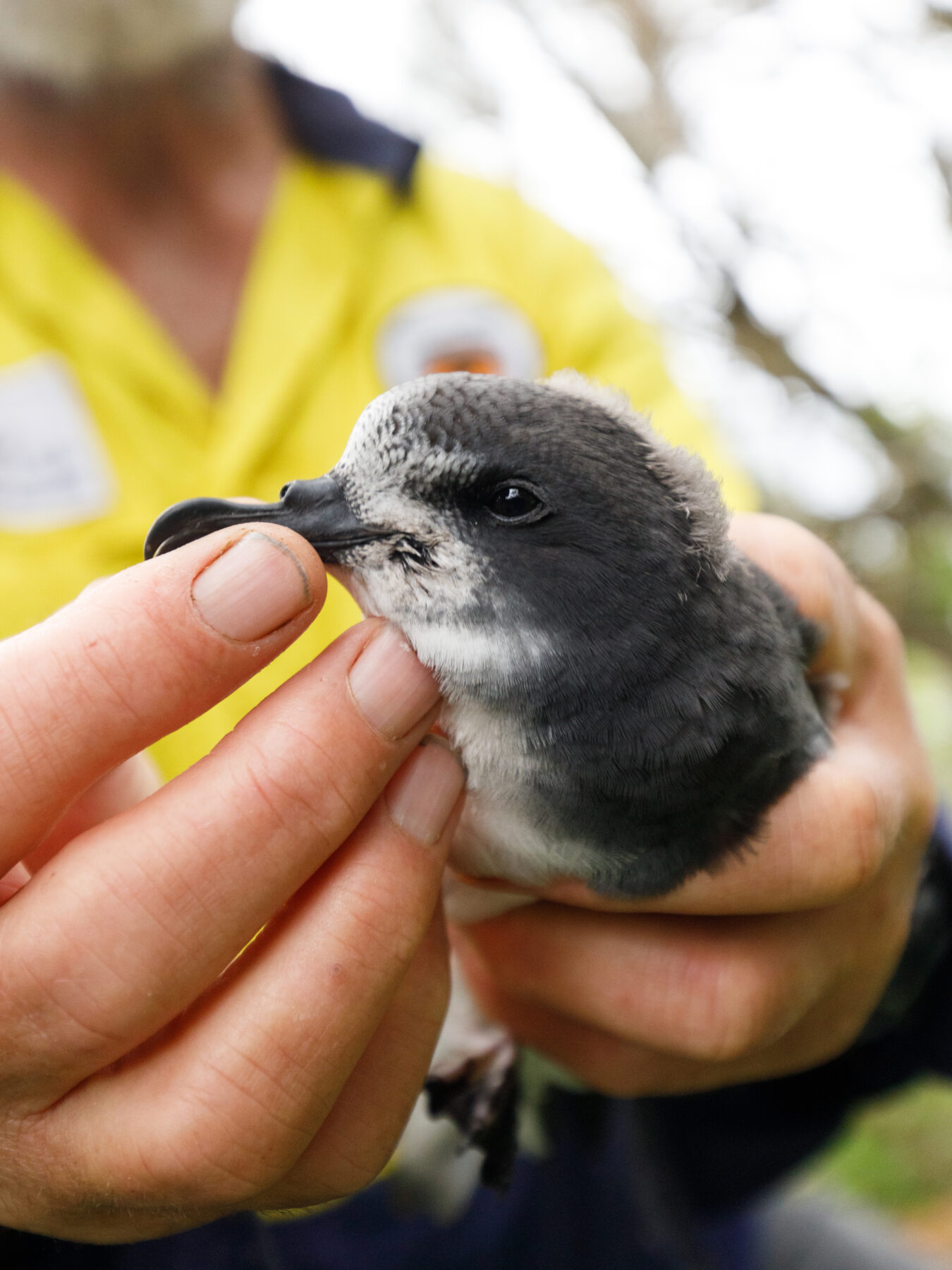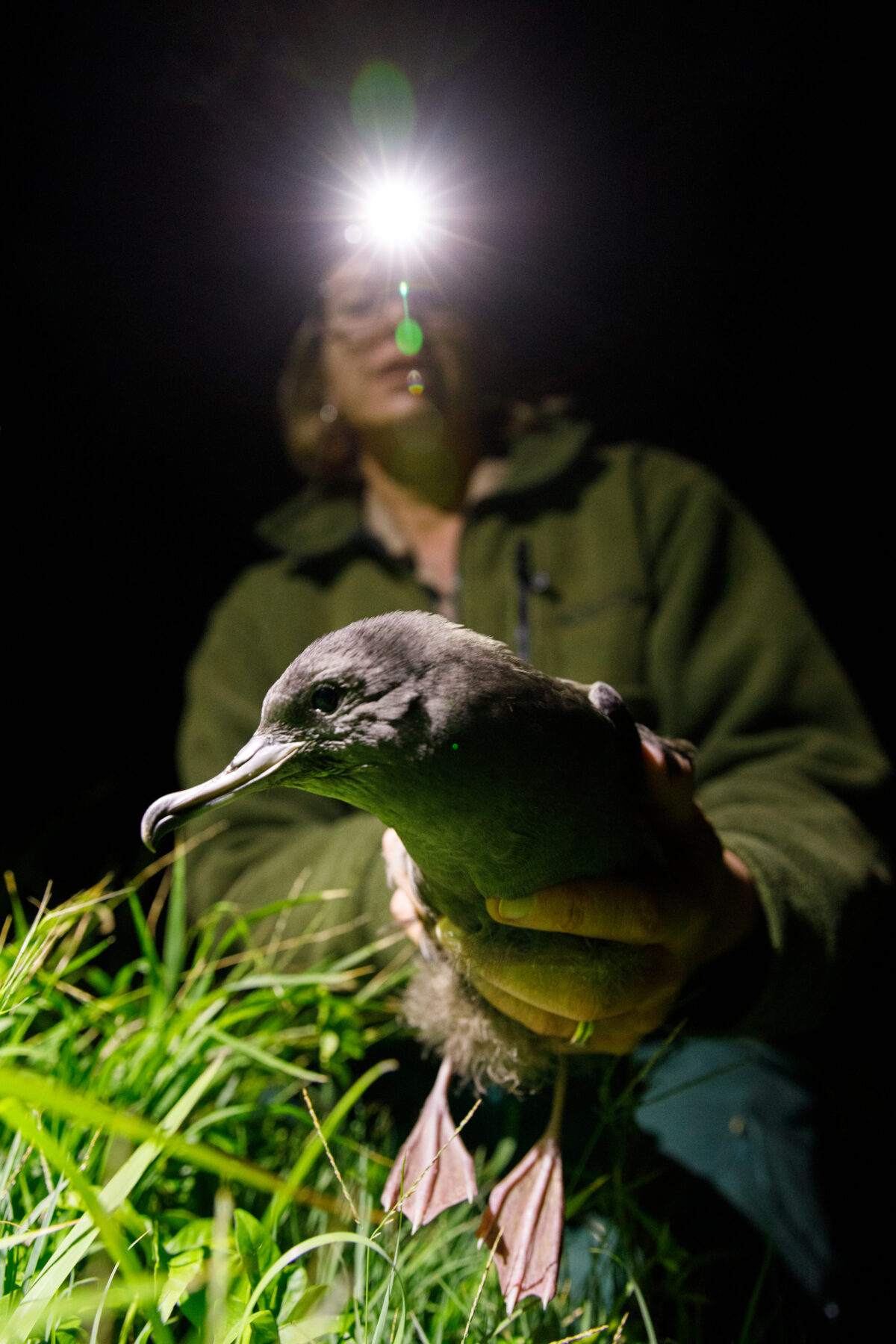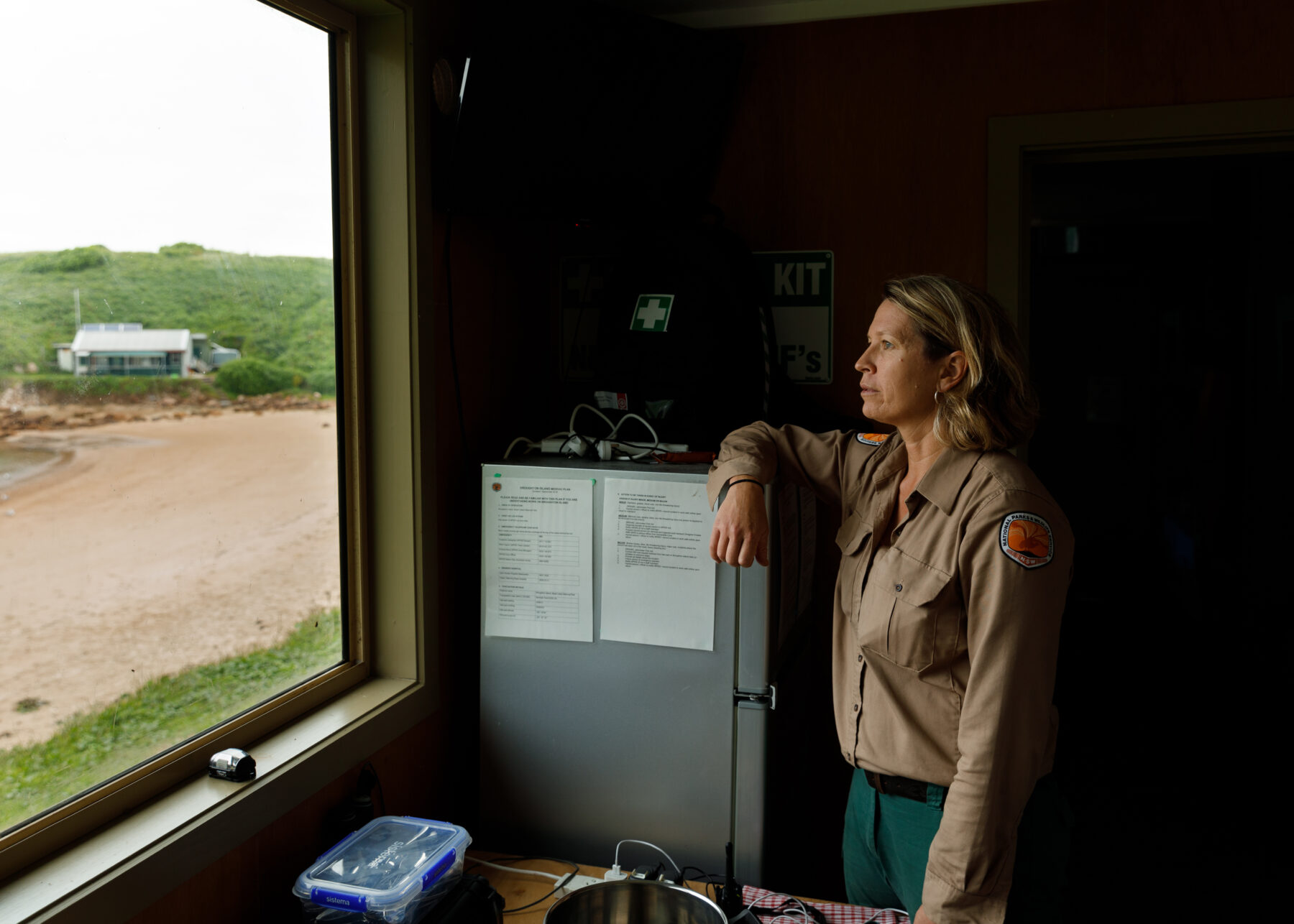Tom Clarke’s voice soars above the turbulent soundtrack of the waves smashing the cliff base far below. “Oh, look at you!” he says in triumph and exhilaration, as though he’s just found a jewel – which, in a way, he has.
Tom is joined by Alan Stuart, a fellow life member of the Hunter Bird Observers Club (HBOC), and New South Wales National Parks and Wildlife Service (NPWS) ranger Susanne Callaghan. Together, they are inspecting six nest boxes under a copse on the north‑east edge of Broughton Island. The trees cling to a steep slope, just before the land tumbles into the Tasman Sea, and they offer some protection from the elements for the boxes and their contents, which are treasure chests in the eyes of this trio. Alan and Tom have been lifting the lid on each of the boxes and peering hopefully inside, while Susanne has been documenting what they find.
“Number two is empty,” Alan called out just moments earlier, followed by Tom’s declaration of “number one empty”. Then Tom had headed to box number three and carefully prised off the lid, leading to his exultant cry. “Looks like a Gould’s petrel,” he whispers as he tenderly lifts a chick from the nest box. “Still got a little bit of fluff, but you’re getting ready to fly, aren’t you.”
More than grasping a petrel, Tom is holding the hope of an endangered seabird species that’s becoming established on this spectacularly sculpted 132ha island, just off the coast from Port Stephens in northern NSW. Although it may feel gloriously distant from the cares of the world, Broughton Island has been within easy reach of the desires and ambitions of wave after wave of humans that have arrived at its shores, from professional fishers and scientists to tourists seeking to get away from it all. Through the years that impact has profoundly shaped – and threatened – life on the island.
But dedicated teams have been working to not just conserve what is on Broughton, but retrieve what’s been lost.
As a destination, Broughton may be alluring, but the journey to the island is – on a calm day, at least – also a joy. The twin-hulled Envision bringing us here slices across the water from the tourist hub of Nelson Bay, then threads between the dramatic headlands of Tomaree and Yacaaba that guard the entrance to Port Stephens before embracing the sea.
The distance from the port’s entrance north‑east to the island is only about 14km. So it’s not far, but the prospect of Broughton holds a sense of adventure among those on board, particularly for Susanne.
Broughton is the largest in a small group of islands sprinkled in this part of the sea, and is administered as part of Myall Lakes National Park. Being the NPWS ranger who looks after Broughton, Susanne has been visiting the island regularly since 2007.
“I still get goosebumps,” she says, as she squints at the sapphire sea sparkling in the morning light. “Every trip offers something new, and it offers a new piece of the puzzle. There are always discoveries. It’s almost like the island reveals a little bit of itself every time.”
Also on board Envision are others who help find the pieces of the Broughton puzzle, including community members of the island’s Traditional Owners (TO), the Worimi, and a team from HBOC. At the vessel’s helm is Stephen Murray, who’s usually transporting daytrippers out here. They come to see whales migrating just beyond the island, to snorkel, or to while away a few hours walking on Broughton. “They love it. It’s just 40 minutes up the coast from the [Nelson] bay and they never want to go back,” Stephen says. “It’s like a deserted island – it has that feel to it.”
As we approach from the south, Broughton Island rises from the sea. It looks dramatically beautiful, wearing its jagged crown of Pinkatop Head, but forbidding, guarded by the waves breaking along its rocky edges.
Then the island relents and invites Envision into the more sedate waters of Esmeralda Cove. At the head of the cove, sprinkled along the shore are eight huts. Most belong to families who have tenaciously held on to these buildings for generations, through tempests, both meteorological and political, that have threatened to sweep the shacks off the island.
The settlement is the most obvious sign of a human presence on the island, but there are others to be found. As we step off the boat and onto the sand, the water embraces our legs. We unload the supplies and trudge up the beach towards the huts, impressing our arrival into the sand with each step.
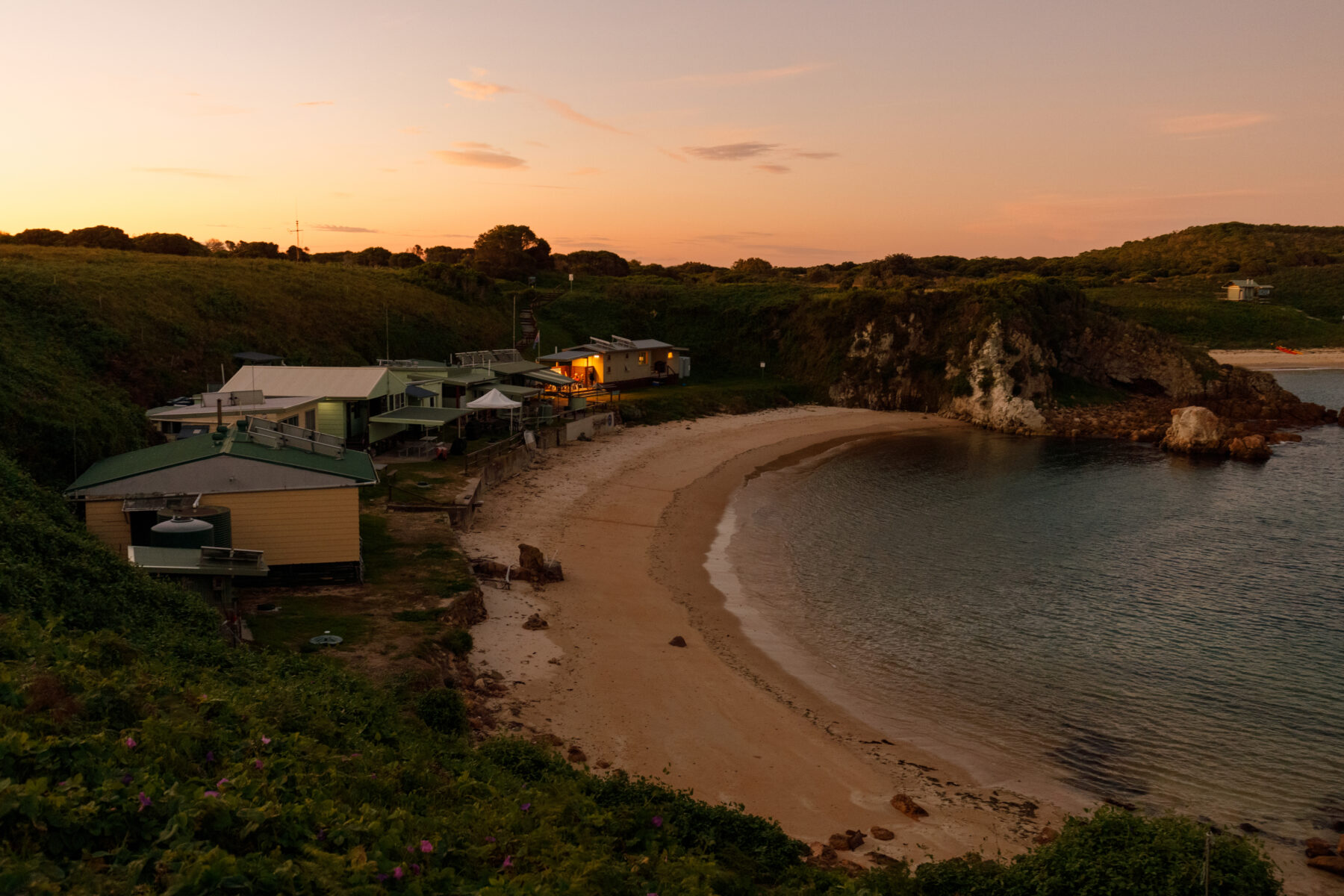
Worimi women, twins Auntie Sheryl Hendry and Auntie Beryl Cowan, point out that our arrival has already been noted. “Mother [Earth] is hearing the footsteps, the vibrations of us being here,” Sheryl explains. The sisters use a stick to trace a drawing in the sand to inform Mother Earth about who we are and what we are doing here.
These women, who’ve spent all their lives in the Port Stephens area, have only recently stepped onto Broughton for the first time – Sheryl just a few weeks earlier at a Worimi community day, and Beryl in 2022. Yet they have always felt a connection to this place just across the sea. “Our belonging place,” says Beryl, of what she feels stepping onto the island. Growing up, the sisters heard stories of women in the mid‑1800s paddling bark canoes 3km or so from Dark Point, the closest spot on the mainland, to the island to fish and collect other food.
TO Jamie Tarrant, chair of the Worimi Conservation Lands Board of Management and also a NPWS officer, listens to the sisters talk of those ancestors paddling to the island. He has no doubt what enticed them across the water. “There’s an abundance of every resource you could ever desire here,” Jamie says. “The fish resources, the birds, the plants; it’s a place of abundance. We know this place is special. You can see it. You can feel it.”
With the Worimi community members is Laura Dafter, a PhD student in archaeology at The University of Sydney. Since 2019, she’s been studying the cultural heritage and archaeology of Broughton Island, working closely with the Worimi community. Her work has underpinned what’s called the Broughton Island Cultural Heritage Research Project.
“To me, Broughton Island is special because it has so many layers of significance,” Laura says, explaining the thickest and most profound layer is the continuing Worimi connection. She says the Worimi would have been coming here for millennia, most likely walking this land before it was even an island. Then the rising seas 9000–6000 years ago formed the island that would be named by the British, apparently in honour of the naval officer who surveyed these waters, Commander William Broughton. Meanwhile the Worimi kept coming to this land.
“I was fascinated about people making that treacherous journey to the island in a bark canoe,” Laura says. “It captured my interest as an archaeologist of how people engaged with the island, and why they wanted to make that journey.”
Laura believes the island has the potential to contribute new information to develop our understanding of Australia’s natural and cultural history. “One of the things that make Broughton stand out is that it has a high density of cultural and archaeological sites,” she says.
The community members and the archaeologist lead me to one of these sites that indicate Broughton Island has been not only a place of abundance, but of industry.
The swishing sound hangs softly in the air as we traipse over a hill cloaked with waist‑high blady grass and lomandra. We’re walking through the heart of the island to its south‑western corner. We reach the rock shelf girding the island’s edge and follow Jamie as he sets a course across the surf-shaped shoreline, stopping at a shelf pocked with dozens of grooves.
“Each of these grooves holding water is where an axe or spear was born,” Jamie says. He believes it was most likely men who would have sat here, shaping and sharpening the pieces for their tools and weapons. “It’s a factory,” he says. “If you look at the rock here, the quality of the stone, it would have been like a supermarket for stone back in the day. This wasn’t just a stopover or a camp, this was an industry of manufacturing stone tools.” Laura says the site holds at least 60 grooves. Jamie adds he isn’t aware of any other site of this scale in Worimi Country.
Wordlessly, the sisters slowly walk between the grooves, peering into the water they hold. Sheryl, who is seeing the site for the first time, sits beside one groove and strokes the stone, feeling its smoothness. “It’s blown my mind to see it,” she says, all the while touching the stone. “You put your hand in there and know our ancestors have been here, doing the same thing.”
Sheryl and her sister look up and gaze across the water to Dark Point on the mainland, from where their ancestors paddled to reach the island. “When you’re at Dark Point, it looks shorter,” Beryl murmurs.
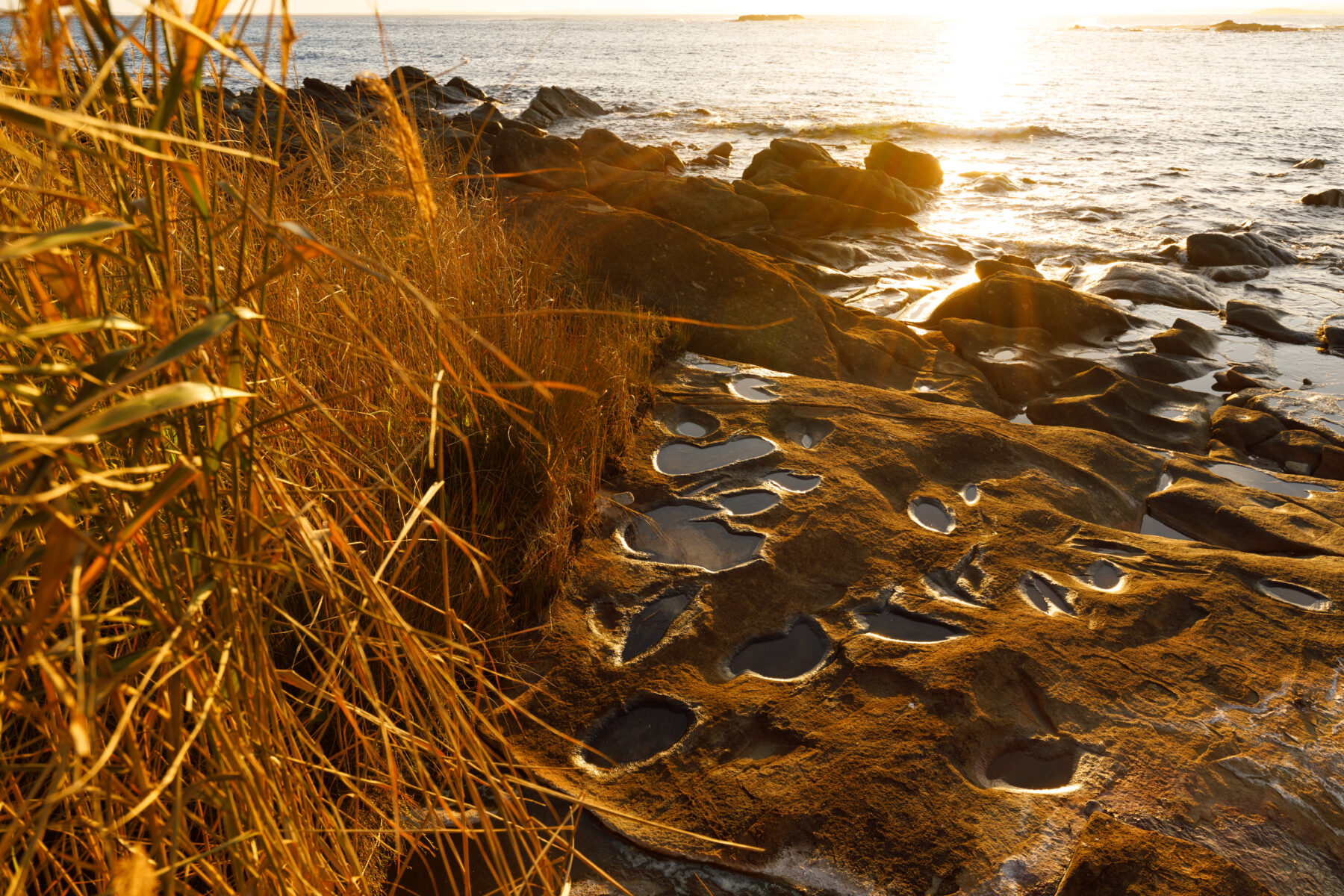
Long after Worimi people began paddling across the water to the island, other fishers turned up at this place of abundance seeking to catch a living. According to John Clarke, local historian and author of the book Broughton Islanders, Chinese fishers worked the island’s waters from the mid-1800s, followed by fishers originally from Italy.
In the early years of the 20th century, Greek-Australian fishers established a settlement known as Little Salonika at the island’s northern end.
Just over the island’s sandy hills and sparsely wooded forests, professional fishers of various nationalities set up camp around what would become known as Esmeralda Cove. Rough huts built from whatever could be boated in – or carried in by the sea – took shape along the shore. Equally rough, it seems, was the atmosphere.
“When the commercial fishermen were there it was putrid, because they had all their bait out to dry, and they used everything for bait,” John says. “It was wild, it was rough as guts.”
In time, the professional fishermen around Esmeralda Cove were joined by those looking for somewhere to fish and holiday beyond the mainland, leaving behind the rules and cares of life back there.
“It was very much a rough, male-dominated domain,” adds John, who’s been visiting the island since the mid‑1970s. Back then, he would see blokes rolling a keg of beer from their boat up to the huts. The hut occupants’ playground was about to become a battleground. After the island was gazetted as part of Myall Lakes National Park in 1972, the huts were effectively on public land. In the 1980s, NPWS looked at options for removing them. Mother Nature had washed away a couple in big storms, but the occupants were not so easily moved by a plan of management.
The hut owners and users formed a group that would eventually be known as the Broughton Island Conservation Society Incorporated (BICSI). The group lobbied politicians and appealed to parliament that the huts should be conserved, for they were not just a place of recreation and part of the island’s tradition, but a shelter for mariners in strife.
Eventually, it was decided the huts could stay. BICSI reached an agreement with NPWS. The conservation society owns the buildings and has a licence to use the sites. As part of the licence, BICSI members pay a quarterly fee to NPWS for each hut.
The fight to keep the huts is etched in metal. On the side of one hut are plaques for three men who were instrumental in “the struggle to retain Broughton Island and its huts for those interested in fishing, recreational activities and camping”. That “struggle” is also imprinted in the minds of families who have been coming to the island for decades.

Sitting under a shelter outside the hut his family has been coming to for five generations is Mitchell Ward, the president of BICSI, along with long-time friend and sometime-neighbour from two doors down, Robert ‘Dick’ Dyer. Both have been holidaying on the island for about half a century, since they were kids.
Mitch gazes at the line of huts. Each has their own architectural style and name, telling something of the building’s history or occupants. The hut that’s a part of Mitch is called Westy-Brook, acknowledging the Hunter Valley hometowns of the two families who have occupied it – West Wallsend and Muswellbrook. I ask Mitch what makes this place special to him. “Memories, just memories, mate,” the retired coalminer replies.
Among those memories is the time when the occupants faced the prospect of losing their huts. Dick’s father, Bob Dyer, was one of the campaign leaders to retain them. If they had gone, Dick says, more than a holiday haven would have disappeared: lives would have been lost at sea. He proudly shows off the emergency radio mounted on the wall next to the plaques honouring those involved in “the struggle”. That radio has brought help to stricken mariners.
“We’ve had quite a few rescues,” Dick says. Other boaters have sought refuge in the huts, when the weather has turned foul.
No-one lives on the island. However, the huts’ occupants also act as de facto managers for the island, because no ranger is based here full-time. The occupants have carried out restoration work on the huts and shoreline, and they keep an eye on visitors. Without them, Dick believes the island would’ve become a littered mess. “I don’t think it would be the same,” he says.
Susanne Callaghan agrees. “The group does a really good job of looking after this place when we’re not here and when we are here, and that’s been for a very long time,” she says. “I don’t see that changing. And I feel like our relationship is at a really good place. We’re working together a lot more than we used to.”
A lot has changed with the huts. The buildings are rudimentary, with bunks in common areas and few conveniences. Broughton’s allure has little to do with convenience, after all. Most people come here to connect with themselves by switching off from contemporary gadgets and comforts. However, some of those gadgets and comforts have been brought onto the island. The huts have solar and battery power, there is a sewerage system (and flushing toilets) and mobile phone boosters have been installed. In Westy-Brook there’s even a television.
“This has got all the mod cons. It’s the fancy one,” Dick says of Westy-Brook. His family’s hut, Broughton Hall, is more modest, but with the same priceless water view.
What has also changed here is the atmosphere. “Beforehand, it was all blokes,” Mitch says. “They’d just come up here to go fishing, have a few drinks. Now it’s also the women and kids.” Mitch’s wife, Shari, joins us. “I call it our Broughton family,” she says. “We know all the families. The kids, they’ve all come here year after year. It’s a beautiful little community.”
The community is not as enclosed as it once was. Broughton Island is increasingly on the tourist map. Cruise boats with up to 80 passengers on board bring people for a few hours relaxation and exploration on the island.
Recreational boaters also make their way into Esmeralda Cove. Some stay overnight, camping on the platforms provided by NPWS, overlooking a strip of sand with views that defy its name, Little Poverty Beach, and surrounded by the cries of shearwaters that nest in their tens of thousands on the island. “It’s the only place in NSW where you can camp in an active seabird colony,” Susanne says.
Setting up their swag on a platform are Chris Gameren and Tonya Pou. The Sydney couple have just arrived from Port Stephens on their speedboat. It’s Tonya’s first time here, and she’s astounded by how quiet it is (at least, by day, before the shearwater chicks come out of their burrows). “It gives me a bit of a Mallorca vibe,” says Tonya, who’s originally from that Spanish island. Chris is returning to his past, having visited Broughton on family holidays when he was younger. To preserve the island’s atmosphere, he says, “the obvious one is restricting the numbers of people”.
Broughton Island has up to 5000 visitors a year. NPWS has a cap of 30 campers at any one time. But Susanne concedes with improvements in boating technology and the growing desire for people to “discover” convenient getaways, the pressure on Broughton Island will grow. “We’re going to have to watch this space very closely over the next 5–10 years to make sure we are still keeping that balance between conservation and visitation,” she says. “I really hope they [visitors] leave with some high level of understanding about the island, because we’ve got to conserve it and have a level of access so that people will understand how important it is.”
More than a century ago, scientists set up on the island in a bid to save Australia’s agricultural land from the scourge of rabbits, but ended up setting off a trail of destruction on Broughton. In 1906 a team of biologists built a laboratory and living quarters on a knoll overlooking Esmeralda Cove and carried out experiments on rabbits brought to the island. The program was abolished after about a year. The scientists left Broughton – but the rabbits didn’t. The introduced species wreaked havoc across the island, chewing away the vegetation until vast tracts were left bare.
Jumping ashore from visiting boats came another marauder, the black rat. For humans, rats were a nuisance. “You used to stay in a hut and have rats jumping over you all night long,” recalls Mitchell Ward, who has been coming here since his childhood. But the rats had a more profound impact on the island’s bird population, eating eggs and chicks.
Although shearwaters continued nesting on the island, another seabird species, the white‑faced storm petrel, soon disappeared. For there to have been any hope of that species returning, both rabbits and rats had to be removed from the island. Susanne and her NPWS colleagues planned an eradication program, involving the controlled release of a calicivirus and the use of baits.
John Clarke recalls Susanne telling him of the plan to deal with the century‑old problem: “I said, ‘Susanne, you’re not going to be able to do it. You’re dreaming. It’s not going to work.’”
In 2009 the service implemented the program – and it worked. “No‑one’s seen a rabbit since,” John says. “Since the rabbits have gone, it’s obvious the vegetation has returned.”
“The island looks nothing like what it looked like 10 years ago,” Susanne says. “It makes me wonder what it will look like in another 10 years. The vegetation has changed, and that’s driving a lot of other changes that we need to investigate.”
To study these changes, teams from HBOC have been travelling to Broughton Island on survey excursions four times a year since 2012. They also introduced a banding program in 2017, to identify individual birds and better understand their movements.
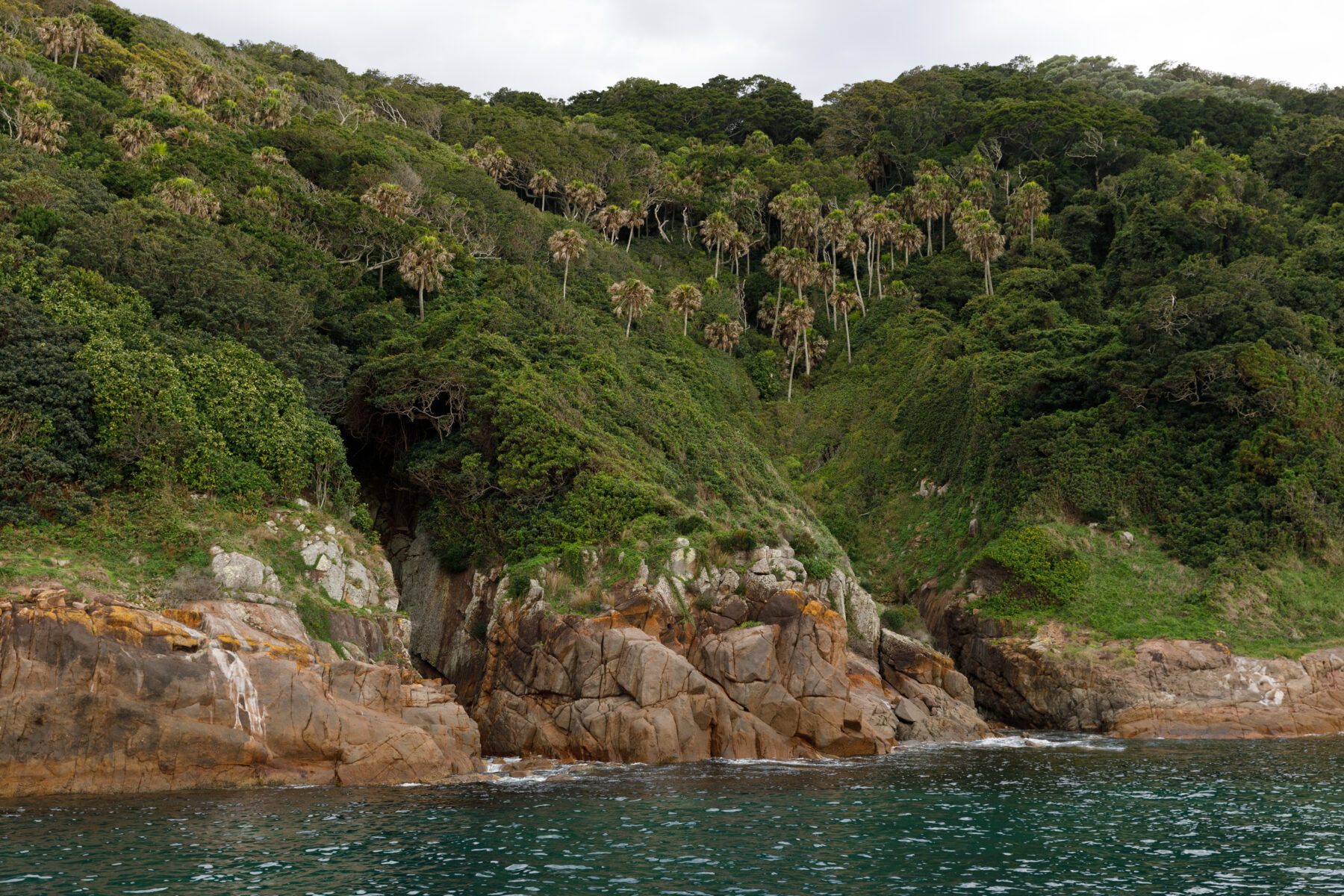
On this occasion, seven club members have made the journey. The bird observers fan out across the island, erecting nets that range from 6m to 18m in length. They regularly check the nets. “You never know what you’re going to get in the net,” observes Judy Little, who’s a lawyer during the week.
In just one day, they catch 79 birds. These are brought to a “banding station”, which is a space between two containers that serve as storage sheds. In the station is a line of wriggling white bags, each containing a bird. Each will be examined, measured and weighed, and if it hasn’t been previously caught and identified, it will be banded before being released. Most of the birds being examined are silvereyes, but there is also a juvenile golden whistler that protests being handled. “Don’t bite me,” Judy says, placing a band on its leg, while it grabs her finger with its beak.
The team members talk as they call out details of each bird. “We’re getting new birds coming all the time (‘this is a 46 tail’) so we check them,” Judy says.
This visit has the team excited about netting a new discovery, a Lewin’s rail. “It’s the first time we’ve caught one on the island in our study,” Alan Stuart says. “We hear them because the call is distinctive, but they’re so secretive. I’ve actually tried many times to catch [one].”
Inspecting the bird’s dense plumage, long-time club member Rob Kyte notes that it’s a juvenile. Before it’s released, the Lewin’s rail is banded to determine if this individual is staying on the island or coming and going. It all adds to the store of knowledge and the growing hopes of a rejuvenating environment.
“We’re seeing species that are increasing in population,” Alan says of the changing survey results since 2012. “We are also seeing species arriving on the island to live here.”
Two species that have needed more enticement are Gould’s petrel and the white-faced storm petrel. The latter once thrived on the island. Susanne tells how historic journals noted there were thousands of petrels here. When asked why they disappeared, she replies with one word: “Rats.”
Alan says that although there have been small colonies of Gould’s petrel on nearby islands, there are no records of the species on Broughton before the pests arrived. But after the rats were eradicated, a faint cry that held echoes of huge encouragement was heard. From the base of the cliff on the northern side of Pinkatop Head, the island’s highest point, came the sound of a petrel. An investigation using a remote camera revealed a Gould’s petrel incubating an egg.
In a bid to attract more breeding pairs to the island, HBOC and NPWS installed nest boxes at the top of the cliff in 2017. There were six for Gould’s petrels and, a little further up the hill, nine for white-faced storm petrels. To put the call out, the team also installed a couple of loudspeakers that emitted a recording of the petrels’ mournful cries.
In 2018 the first breeding pair of Gould’s petrel was spotted in a box. Then the following year, an egg. In all, there have been eight Gould’s petrel fledglings from the nest boxes on the island.
“It’s just fantastic,” Alan says of the program. “It’s the greatest excitement when you see an adult with an egg, then a chick, then it’s fledged. It’s, ‘Hey! This is working!’”
If the journey to attract the petrels has been a slog, so too is the walk to inspect the nest boxes. The trek from Esmeralda Cove to Pinkatop Head is not far as the crow flies – about 1.3km – but it’s an odyssey on the ground. We clamber through thick vegetation that’s sprouted since rabbits were eradicated.
By way of pain relief, the route offers spectacular views over the island and down the coastline of the mainland, and of the sea.
After 45 minutes hiking, we reach the trees sheltering the nest boxes for the Gould’s petrels. Before opening them, Alan mentions that a couple of months ago there were two chicks.
Tom has his moment of joy when he opens box number three. “There you go, darling,” he says quietly as he puts the bird back into the nest box, then turns to continue speaking to me. “I admire them,” Tom says. “They’re gorgeous-looking things. And their lifestyle. This bird is going to leave this island, fly around the ocean for maybe up to five years, before it gets the signal to breed, so it might come [back] here.”
“Chances are when they do decide to breed, they’ll come back here because it’s imprinted on their memory,” Alan says. The lid‑lifting continues. In box six, there is a shearwater chick. Box four is empty, just as numbers one and two were. That leaves just box five.
“This one must be a winner,” Alan predicts, as Tom lifts the lid. “It’s empty!” Tom says. “It’s gone, it’s fledged,” Susanne adds. “From fluffy ball to seabird,” Tom murmurs.
The storm petrel nest boxes are also checked. They’re empty. So far, there’s been no sign of a white-faced storm petrel having bred in the boxes. But Alan is optimistic. “I hope to see the Gould’s petrel colony grow in size and using natural nesting cavities as well as boxes, and that we find the storm petrels.”
“We’re having some wins,” Susanne says of the petrel project. “While it’s still a small colony, it’s a very important small colony. It’s important because, one, it’s a very rare seabird, it’s a threatened species. And, two, [it shows] that management actions can have real outcomes.”
As poet John Donne wrote, “No man is an island entire of itself”. The Worimi community members who are with us today emphasise that the island needs humans to work together. To demonstrate the point, they produce a mat that Laura is weaving from strands of fibre. “Laura makes up one of these threads, the birdos make one of these threads and Suse makes a thread,” Jamie explains. “So the day we’re all working together as a community, this mat will grow.”
“We’re all on this mat now,” Sheryl adds.
“And if everyone doesn’t work together, there is just a pile of separate strands,” Jamie says. “And no mat. As a result, the island would suffer.”
“I think this place means so much to everybody – the huttos, the community, National Parks,” he continues. “We’ve got too much to risk and we all have to work together for the best outcome for everybody.”
Yet, for an island that’s not even 3km long and is less than 2km at its widest, and cradling a fragile environment, Broughton is expected to carry a lot of human hopes and expectations. So is the island big enough to hold all of that? As she gazes at the waters in Esmeralda Cove, Susanne laughs and replies, “I think the island is bigger than Ben-Hur! It’s 132ha, that’s its physical size, but in people’s minds and people’s hearts, it’s a lot bigger. It is a little island, but it is a big island.”

